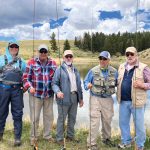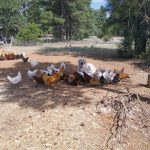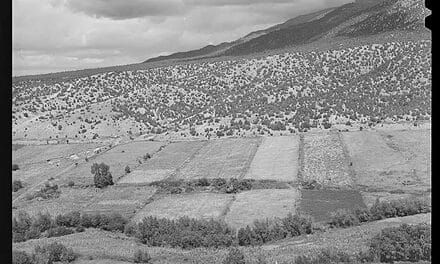
From left to right: Clarence Hogue, Rebecca Grashuis, Eileen Shendo, and Merlin Toya-Lucero.
The Indigenous Farm Hub (IFH) cultivates seventeen acres in Corrales, with four acres in vegetable production and the remainder in hay and cover crops, providing 140 families with produce through their CSA program. The farm is not only a food source but a hub of learning, growth, and prosperity building. Its core initiatives include connecting language and land-based learning for students at the Native American Community Academy and other schools; working to strengthen food networks in Indigenous communities; and running a farmer residence program that supports three farmers on fair salaries every year.
PEOPLE
Clarence Hogue, farm director and director of communications and outreach: I grew up on a farm . . . it’s kind of nice that I’m back where I started, back to my roots.
Merlin Toya-Lucero, farm coordinator: Growing up, I wasn’t really into it. We had some elders back home who did farm, but that wasn’t really practiced by my generation. After maturing, after life humbling me, and learning more about the world and climate change and healthy food and eating . . . I was finally like, I get it. Farming is important. I want to do that.
Alan Brauer, farm facilitator / senior director of initiatives and programs: I grew up on a dairy farm. . . . Farming is kind of in my bones.
DJ Ladabour, FoodCorps service member: I’ve always worked around food. I’ve been a cook. Once I started farming and spending every day outside, taking care of the land, it put me back in a place where I wanted to reconnect.
Rebecca Grashuis, farm to school education coordinator: I started off doing traditional medicine practices when I was a kid—that was my first connection working with the land and working within Chicano culture. . . . I got into farming seven years ago. I started off with organic, small-scale urban farms because I thought that it would be easier for people in urban communities to start to build up food systems outside modern food systems that were failing us.
Eileen Shendo, beginning farmer resident for 2022: I’ve been growing with my grandpa and my family since—that’s how we were raised. I think for us as Pueblo people, in order to make our culture and identity, you have to grow. Because for one, we use corn from the moment of birth to death. If we don’t maintain that, we lose everything.

DJ Ladabour.
GROWING FOOD, GROWING FARMERS
Alan: We know there’s so many strengths happening right now across Indigenous communities, but we felt like there was a lack of opportunity for capital. A lack of opportunity for access to things like drip tape irrigation or water access. Access to selling your products if you are interested in growing more than just for your family. So there are a lot of realistic obstacles that are in place, especially within Indigenous communities, to access opportunities and build prosperity as farmers.
We’re growing food; we’re not demonstrating how to grow food. We wanted to ignite love of learning for growing food, but we also wanted to make sure that we were at a scale that we could support people with the food. Thus sixteen acres that we have [at this site] and that we’ve been working with a landowner to purchase one piece at a time. We want to make sure [IFH] is sustainable and we’re able to grow enough food that we can eventually make sure that the salaries for our staff and the production can make ends meet.
There’s about sixty thousand farms that are considered Native-American–run in our country. I think 75 percent of them make less than $10,000 a year, and 92 percent make less than $50,000 a year. Even if $50,000 was a fair income for the farm work that you have to do, when you only have 8 percent of the population of Native farmers that are making that. . . .
So we center our farmer residence program on the vocational aspects of growing food at a production scale. Everything from planting schedules to successive planting to using different varieties of amendments to the soil to using drip tape irrigation to flood irrigation.
Rebecca: A lot of times, farming is taken as unskilled labor, whereas it’s highly skilled. There’s very few people in my age range that I know who can run a production farm like this. If we can start to allocate value to our food systems and to the importance of building resiliency within communities, especially through food, then we can start to see some really lasting change in our health and our connection to each other as people.
Merlin: I always thought farming was like, put a seed in the ground, water it, hope for the best, and it will grow. But there’s so much more to it. Work, commitment, dedication.
I really like the labor; I like not just working with my hands but getting farmer strength. Learning how to properly hold a shovel. It’s rewarding. And learning about all these different cruciferous vegetables and the health benefits you get from them.

Alan Brauer.
COMMUNITY
Eileen: The First People of New Mexico have been left out a lot in developing food systems. I’m speaking for myself, specifically as an individual from Jemez and Cochiti Pueblo. . . . In Indian Country, our food systems were one of the first means—so whether you look at how we grew or how we lived, or animals, and that sense of our livelihood—[that] were intentionally exterminated. For me a big part in our work with the Indigenous Food Hub, not only with landowners or traditionalists who are agriculturalists but especially with Native women, is to really see how they can create an economy off what they love.
Clarence: There’s a lot of places in our state where people don’t have access to food as readily as here in Albuquerque. That’s my experience growing up is we had to drive at least thirty miles to get to a grocery store. So we need to start thinking about how we can work more with communities and help them strategize solutions for getting better food access and really supporting local farmers, creating systems so that the most rural communities and farmers can also contribute. The bottom line is really about getting food out to people who need it.
Merlin: Diabetes is a really big issue, especially where I’m from. Around my junior year in high school, I started realizing, I don’t want to get that—I wanted to be that [small] percent of Laguna members that aren’t diabetic and don’t have any preexisting conditions and try to be as healthy as I can.
INVESTMENT
Eileen: If people or private funders, whoever, could actually invest in people directly, or with tribes, [farming] would be more self-sustaining. Because right now, there’s millions of dollars—billions—that are going out for food system development. But [the funds] go through large nonprofits, which basically get taken out by indirect costs and overhead, and then end up [telling] farmers, “Go try to do this with $3,000.” Or give $10,000 of seed money, and hopefully it works. And I think that’s the part that is discouraging because it’s really not meeting the need when we know it could. And it’s not supporting systems that have been effective for time immemorial.
Rebecca: If we can build interest, if you start getting kids connected in elementary school—how do you grow a plant? What do you do with compost? What’s in a watershed? And then in high school we have a focus like, if you want to get into agriculture, there’s value in it. There’s respect in it. There’s connection with your ancestors and there’s connection with the generations you’re feeding.
DJ: Farming is a huge aspect in my everyday life—I’m thinking about saving seeds and planning ahead for not only this place but my grandma’s house and other people’s gardens that I’m helping out with.

Clarence Hogue and Eileen Shendo.
CLIMATE
Clarence: Water is a big part of what we do here, so if we don’t have the water, we can’t do a whole lot. We have a big irrigation system over there, we have a well that we use, that’s where we get the water to do a lot of our drip tape. We’re lucky that we can do that-—a lot of places don’t have that.
Last summer, they told us we were probably only going to get two waterings [from the acequia], maybe May and June, and that was it. . . . They only allow you sixteen hours the one time you get water, and they really monitor you. Even if you’re ending at midnight. Based on that, you know something is different. Something is changing.
CROPS
Clarence: We did really good with onions. I like onions.
Eileen: Tomatoes, chard, kale.
Clarence: Corn—we did blue corn and white corn, native corn—
Eileen: Chiles.
Clarence: Melons, unfortunately—we had some unwanted visitors. Coyotes were eating our melons. Otherwise we would’ve done good with melons.
DJ: Sweet potatoes, peanuts, big leaf kale. We have a vegetable preference survey that we give out to FoodCorps.
Clarence: Certain things grow better at different times. Like peas. But some things hold you through the summer. Even that is an education.
DJ: After tasting the difference, going through the whole process of growing it and using it, it’s a lot better. It just tastes a lot better. It feels a lot better too.

DJ Ladabour.
Note: This interview was edited for clarity and length.

Briana Olson
Briana Olson is a writer and the editor of edible New Mexico and The Bite. She lives in Albuquerque.
















